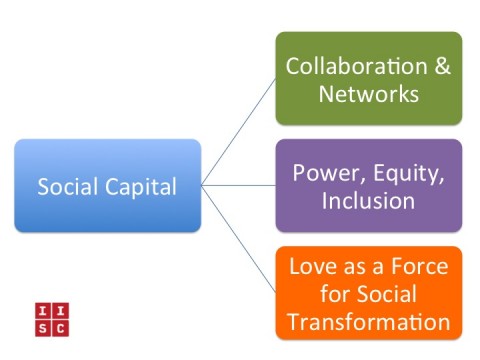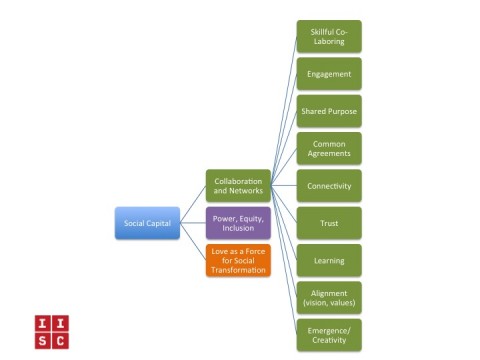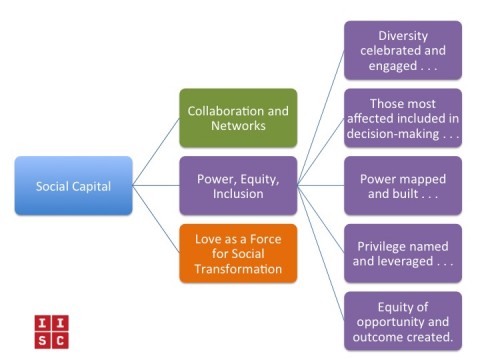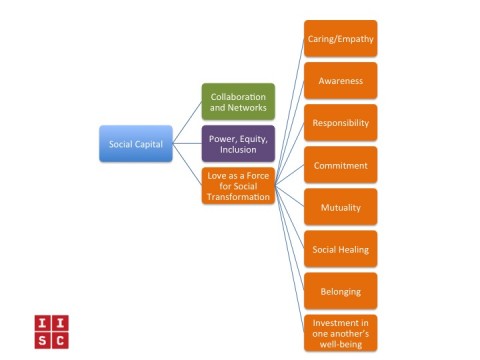Complete (Social) Capital
This article was originally published on the Interaction Institute Blog.
Last week I represented IISC as a presenter/facilitator in a “deep dive” session at the Council on Foundations Conference for Community Foundations. The title of the session was “Complete Capital” and was inspired by an SSIR article by the same title written by Antony Bugg-Levine of the Nonprofit Finance Fund (NFF). Briefly, complete capital is a framework to help funders and other investors develop a fuller picture of the assets required to address complex social challenges: financial, intellectual, human, and social.
After presentations by Alison Gold of Living Cities (intellectual capital), Lisa Spinali (human capital) and Jessica LaBarbera of NFF (financial capital), and in the light of a couple of helpful case studies presented by Alison and Jessica, I offered a view of social capital that is more complex than what appears in the SSIR article. Why make it more complex? Because as much as there is talk about it, we still confront challenges when it comes to getting people to fully invest in ways that maximize social capital. And because in our experience there is so much more to the conversation, especially in the context of social change work, that goes beyond simple mention of collaboration and partnerships.
So I presented a more detailed picture by illustrating what would happen if we send the relatively narrowly defined concept of social capital through the “IISC prism” of collaborative capability building. This prism is composed of facets representing the “lenses” we bring to our collaborative capacity building work: networks, power/equity/inclusion, and love as a force for social transformation. The question guiding my brief presentation: As the light is refracted, what do we see as more nuanced, potentially overlooked, and critically valuable social assets that both support and constitute the work of social change?

First a bit more about our lenses:
- Collaboration - This is not really a lens, but the foundation of the prism and our practice at IISC these past 21 years and embodied in everything we do with respect to training, facilitation, and consulting. We strive to help people be skillfully better together to achieve progressive social change.
- Networks - Over the past decade in particular, we have come to believe that the unit of action for social change is the network not the organization. Working through networks invites us to build relationships and trust across boundaries, understand existing patterns of connection and what these facilitate in terms of outcomes and possibilities, and create fluid boundaries for engagement and space for emergent thinking and action.
- Power/Equity/Inclusion - In our work, we strive to ensure that individuals and groups who are most affected or marginalized are meaningfully engaged in decisions that affect their lives. We are dedicated to exposing and challenging systems and processes that produce inequitable opportunities and outcomes. We also strive to build the powerof those on the margins – their capacity to bring about positive change – so that new ways of working and living that model justice can emerge.
- Love as a Force for Social Transformation - Dr. Martin Luther King, Jr.’s notion of creating a just and democratic society through “beloved community” is also integral to our work. While love can be difficult to define or talk about, we know that the work of equity and justice is advanced when it’s done in the context of a certain quality of intention, interaction, and authentic relationship. For this reason, we actively move beyond purely transactional modalities and bring into our work a set of practices that support deeper reflection, awareness, and human connection.
With these in mind, if we follow the “beam” of social capital through the prism composed of these lenses, we might see it refracted into some of the following social assets, particularly with respect to our efforts to cultivate collaboration and networked ways of seeing and doing:

And when we look at some of the assets that manifest through the lens of dedicated work around power, equity, and inclusion:

Lastly, when we hold up the lens and practice of cultivating love as a force for social transformation, we might see some of the following assets:

Initial reaction in the conference session seemed to be very positive, inspiring conversation about the need and desire to focus more squarely on racial inequities and privilege in our institutions and communities, pay attention to some of the “squishier” yet very critical aspects of social capital as seen through the lens of love, and a desire to keep the conversation going, in networked fashion!
To be clear, this breakdown of social capital is not meant to be exhaustive and is very much a work in progress. That said, in our experience at IISC, these are some of the critical assets necessary not only for supporting work towards, but also constituting, social change. We also recognize that there is dynamic interplay and reinforcement that occurs across these lenses, such that the assets enhance one another, often significantly, and removing one lens diminishes overall value, often significantly.
Our hope is that our lenses will bring greater validation for, interest in, and commitment to cultivating more robust social capital for just and thriving communities. How we go about doing this effectively is our ongoing question and work at IISC and is addressed in reflections on our blog as well as in our trainings and consulting engagements. And we are interested in knowing about others’ challenges and successes around cultivating more complete social capital. We look forward to hearing your stories and reactions.
Curtis Ogden is a senior associate at the Interaction Institute for Social Change.
